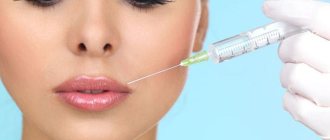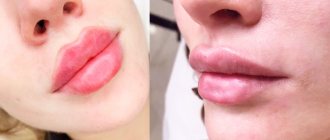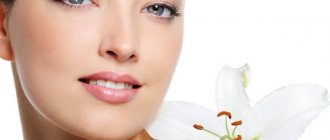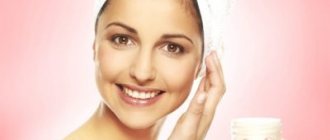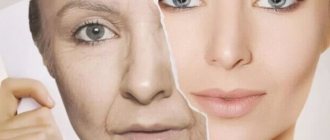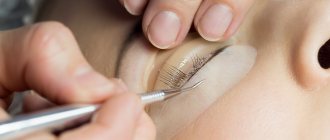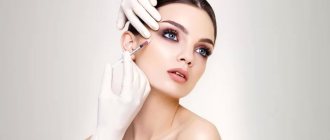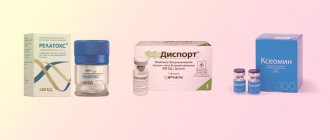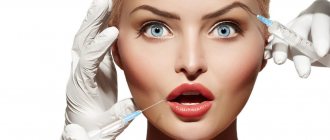Are you ready to inject yourself in the face with a terrible poison, four kilograms of which can destroy all of humanity? Get to know: botulinum toxin is the active ingredient of Botox, used to smooth out wrinkles and treat muscle dysfunction. The “miracle” of the late 20th century, which enriched its creators with billions of dollars and crippled the natural beauty of millions of women.
The cosmetic industry everywhere imposes injections of botulinum poison. They claim that it is highly diluted and therefore safe. This is wrong. The very principle of its effect is pathological: botulinum toxin paralyzes nerve impulses and atrophies muscles. The effects of Botox on the face are ugly and unhealthy. A woman before and after injections are two different organisms. And “before” is always much better.
Therefore, before you step over this line of no return, look at the photos of the “victims” before and after using Botox for the face. Understand the mechanism of action of this drug, all its proclaimed “pros” and real cons.
What is Botox
Botox is a drug based on Botulinum toxin, the most powerful organic poison in the world.
Botulinum toxin is a neurotoxin, that is, a poison that affects nerve cells. It has many names: botulinum toxin, botulinum toxin, botulinum poison. Literally, Botulinum toxin translates as “sausage poison.” It received this name because it was discovered as the causative agent of mass food poisoning with ham with fatal outcomes (19th century). It turned out that spoiled sausage produces the terrible bacterium botulism (Clostridium Botulinum), which causes the disease of the same name, which manifests itself in severe damage to the nervous system as a result of toxin poisoning.
Initially, the military decided to use the damaging effect of botulinum toxin. Experiments with this poison as a bacteriological weapon were conducted in several countries. And its production was first established in the USA: during the Second World War, highly purified botulinum toxin type A (BTA) - the most dangerous for humans - was obtained here. About 30 years later, the BTA was adopted by the US Army under the code XR. It had the form of an aerosol and killed the enemy within three days after exposure to the gas.
It was BTA, created as a biological weapon, that became widespread in medicine and cosmetology.
Botulinum toxin was first adopted by ophthalmologists, using it to treat a variety of muscle disorders of the eyes: strabismus, involuntary spasms in the form of blinking (blepharospasm) and frequent oscillatory eye movements (nystagmus). Then the scope of application expanded. Botulinum toxin has been used to correct a variety of neuromuscular disorders of the face, neck, and legs, ranging from teeth grinding (bruxism) to cerebral palsy. BTA also began to be used for headaches and excessive sweating.
The main jackpot from putting biological weapons on the rails of commercial medicine was hit by the Irish company with American roots, Allergan. It was she who launched the production of BTA for medicine (later for cosmetology), called it “Botox” and now earns about 3 billion dollars a year from this.
Botox came to cosmetology in the early 90s after a side effect was discovered from its treatment of muscle disorders of the eye: the patient's skin between her eyebrows became smoother.
Botox for hair Honma Tokyo: composition
Manufacturer Honma Tokyo promises that their H-BRUSH Botox Capilar acts at the cellular level, filling the hair structure and restoring it. The advertised composition of Honma Tokyo Botox is N-Acetyl cysteine, Luna Matrix system (Silver Matrix), elastin, green tea extract, prakaxi oil.
But let's not blindly trust promises. Let's look at the label. And we are horrified. The next few positions after water are occupied by cheap surfactants, the same surfactants that are used in mass-market cosmetics. This:
- Cocamidopropyl betaine.
Among other things, it has a conditioning effect: it facilitates combing and prevents electrification. As with any chemical, local allergic reactions are possible. - Cocamide DEA.
Used to improve the appearance of the product and give it thickness. Has a softening and antistatic effect on hair. A number of scientists talk about its carcinogenicity, the ability to cause cancer. The fact that this is an unsafe component is evidenced by the fact that there is a standard for permissible concentrations of this substance in cosmetics. There is information that side effects may include dry hair, itching, and dandruff. - Triethanolamine.
Preservative and solvent. May cause dry skin, peeling, irritation, itching, burns. The permissible level of content in substances of prolonged contact with skin is 5%.Next comes the also popular chemistry:
- Phenoxyethanol.
Known as a repellent, that is, a means to repel insects. In cosmetics it is used as a preservative. A regular on top cosmetic ingredients that are irritants. The permissible concentration in cosmetics is 1%. Prohibited in organic cosmetics by all European certificates. - Guar Hydroxypropyltrimonium Chloride.
The detangling conditioner thickens and moisturizes hair. For some, it leaves a feeling of unwashed hair - “icicles”. - Sodium chloride.
Everyone knows it as table salt. In cosmetics it is used as a thickener. May lead to dryness, irritation and hair loss. Neutralizes the effect of keratin. Will you voluntarily rub salt into your skin and hair?
The list of cheap chemicals in Honma Tokyo Botox is completed by several more synthetic preservatives, fragrances, stabilizers, and alcohols. And only the last two components - 2 out of 18 (!) - have something in common with the useful composition that the manufacturer promises. This is green tea extract and prakaxi tree oil. All! Considering that they are at the very tail of the lineup, their number is miniscule.
Conclusion: the entire effect of Honma Tokyo Botox is based on the most ordinary chemistry used in economy segment products. This is how unique compositions with intriguing names are created! Matrix of silver! And now the fanfare: 250 ml of this “Botox” costs 2.5-3 thousand rubles.
Main types of Botox
Usually the word “Botox” is used as a common noun to refer to the entire category of drugs used for botulinum therapy. Although, in the strict sense of the word, Botox is a trademark, that is, just one of a number of drugs based on botulinum toxin. Botox is the first and main drug based on BTA, but not the only one.
There are also trademarks of other manufacturers: Dysport, Botulax, Neuronox, Refinex, Xeomin, Nabota, Meditoxin. They are made in the UK, South Korea, France, and Germany. They also established their production of “miraculous” injections of “youth” in Russia, calling the poisonous product the serene name “Relatox”.
All these drugs contain the same active ingredient – botulinum toxin type A in a highly diluted form. The same BTA, once developed as a biological weapon for military and sabotage purposes.
Use of botulinum toxin
In the past, botulinum toxin injections were used only to treat neurological diseases, such as getting rid of spasms and muscle hypertonicity. Today this method is more known in cosmetology.
Botulinum toxin fights fine and deep wrinkles, improves the condition of patients with hyperhidrosis - excessive sweating. Injections are made not only into the muscles, but also into the sweat glands in the armpits, feet and palms. Eliminate spastic paralysis of the facial muscles, tics, pain syndromes and other similar diseases.
Botulinum toxin type A is excellent for cosmetic and medical procedures - it rarely causes an allergic reaction and is biocompatible with tissues. Contained in the most famous drugs for beauty injections - Botox, Dysport.
How does Botox work?
The so-called benefit of Botox for the face consists of a temporary cosmetic effect: wrinkles in the injection area are smoothed out for 2-5 months. But this is a misleading result. Even highly diluted poison remains poison and causes irreparable harm to beauty and health. It is the damaging properties of botulinum toxin that formed the basis for its cosmetic use.
The mechanism of Botox’s effect on expression lines is insidious. Botulinum toxin blocks acetylcholines, whose function is to transmit nervous excitement. The signal from the nerve to the muscle stops. No nerve impulses - no movement in the muscle. She becomes paralyzed and stops working. This is “relaxation” - an immobilized, non-living face.
Botox and keratin: comparison of compositions
Some people are interested in the question of which is better: Botox or keratin hair straightening. The procedures differ in their cosmetic effect. Unlike Botox, keratin is primarily aimed at straightening hair.
We have already proven that hair Botox does not have a restorative and healing effect. Keratin straightening does not take on such tasks.
The composition of keratin straightening products is also heterogeneous. There are options with formaldehyde. Lots of chemicals.
Why is Botox dangerous?
Someone, influenced by the inspired rhetoric of cosmetologists, may object: “Just think! The muscle is not removed. He’ll rest a little and recover in six months.” No no and one more time no!
- Firstly, it will not recover. There is clinical evidence that even after a single injection of Botox, the muscle does not return to its previous state.
- Secondly, we understand that everything in the body is interconnected. If one muscle does not function, then others work hard for it, without stopping to perform their usual load. And these are serious, deep-seated problems! Muscles, forced to work for their atrophied colleagues in the workshop, become overstrained, wear out faster, and the vectors of skin tension change. And the owners of a smooth and motionless forehead after a few months clutch their heads: not only the old problems have returned, but also a lot of new wrinkles, bumps, and creases have appeared. What to do? Urgently run to the cosmetologist for a new dose of poison.
- Thirdly, scientists have proven that botulinum toxin spreads throughout the body. Only part of it is retained in the injection area. The rest of the neurotoxin moves menacingly and unpredictably from neuron to neuron. It is impossible to predict when and what part of the body affected by the poison may be paralyzed.
- Fourthly, side effects from Botox use kill beauty and health. And they are not a rarity, but a pattern.
Consequences after Botox for the face
The most harmless side effect of Botox injections into the face is bruising. The needle damages the vessel and a hematoma develops, which usually does not go away for about a week. 9 out of 10 patients experience this.
But Botox injections are fraught with much more unsightly changes in the face:
- Sliding and overhanging of the forehead muscles, atrophied due to poison, over the eyes. Paralyzed muscles pull down the eyelids and eyebrows. This is the most popular negative effect of Botox for the face.
- Closed or half-closed eyes. This disorder is the result of paralysis by Botox of non-target muscles located in the vicinity of the injection site.
- Scary bumps above the eyebrows. Appear due to uneven distribution of muscle tone at the injection site. They still hurt.
- Eyelid hernias and swelling.
- Uncontrollable grimaces - instead of healthy facial expressions that correlate with emotions.
- "Mask-like" face.
- Crooked smile.
- Facial asymmetry.
In addition to aesthetic side effects, there is a whole tome of harmful health effects of Botox. Here are just a few of them:
- headaches and migraines,
- osteoporosis of the skull,
- disturbances in the functioning of the cranial nerves,
- disturbance in the functioning of the nerve centers of the heart,
- skeletal muscle dysfunction,
- speech disorder,
- swallowing disorder
- anisocoria of the pupils (different sizes),
- mydriasis (pupil dilation),
- strabismus,
- blindness.
If you were wondering about the pros and cons of Botox for the face, we hope we answered it. There are no advantages. Only disadvantages. Botox pushes the aging process of the face, gives ugly complications and puts the health of the entire body at risk.
Possible side effects
Complications occur when the cosmetologist’s recommendations are not followed or when the dosage of the drug is incorrectly calculated.
Side effects:
- Swelling. Most likely to occur in people with vascular diseases, hormonal imbalances and alcoholism. Often the swelling goes away on its own after a few days. If the swelling does not go away, you need to contact a cosmetologist again.
- Facial asymmetry. If the drug spreads beyond the target zone, asymmetry appears. In this case, it is often impossible to correct the shape of the face; you should wait until the botulism is eliminated by the lymphatic system. Additional injections for correction may worsen the problem.
- Articulation problems. They arise due to too much injected volume of the drug into the corners of the lips or into the muscles that control their movements. Possible drooling.
- Headache. This consequence is caused by overstraining some muscles while relaxing others or improper recovery after the procedure. In some patients, the headache persists for up to two weeks.
- Seals. If the drug is distributed unevenly, bumps appear under the skin. This occurs due to an excessive dose of the administered drug or an individual reaction. The seals can be corrected 2 weeks after the session.
Side effects that do not indicate problems are dizziness, a slight rise in temperature, nausea, and weakness. These unpleasant consequences will soon disappear.
A critical condition after botulinum toxin injections is indicated by numbness of the limbs and rapid heartbeat. If these signs are noticed, you should consult a doctor as soon as possible.
Indications for the use of Botox
Cosmetologists urge Botox injections into the face of those who have facial wrinkles, “jowls” (sagging skin in the cheeks and chin), unclear contours, and facial asymmetry.
A terrible trend is to drag young girls into their networks. Botox for the face, it turns out, is already “necessary” for 25-year-olds, in order to prevent age-related changes. Nonsense!
Don't fall into this trap! Once again in capital letters: BOTOX ACCELERATES AGE CHANGES IN THE FACIAL. And at the same time, having injected yourself once or twice, you will become hooked on the needle. And there will be no way out of this vicious circle.
There are quite a few official contraindications to the use of Botox: oncology, chronic diseases of internal organs, infections, hernias and ptosis of the eyelids, pregnancy, poor skin coagulability. But common sense dictates that Botox for the face for aesthetic purposes is contraindicated for everyone!
Lash Botox: composition
A separate topic is eyelash botox. For the procedure, a special product is used: Lash Botox and analogues. Manufacturers are also loudly trumpeting about the natural and healthy composition, although eyelash Botox products are based on synthetic substances. And the main cosmetic effect is achieved by dyeing and curling eyelashes. With such an aggressive chemical and mechanical effect on eyelashes, it is very difficult to believe that Botox restores eyelashes. Another empty words.
One of the recent publications on our website was devoted to eyelash Botox. If you are thinking about this procedure, read our article first. It contains the whole truth about the composition of eyelash Botox, side effects and mechanism of action.
The best way to combat age-related changes on the face and restore hair is natural rejuvenation with the help of an effective set of exercises. An option endorsed by hundreds of thousands of women is MelAnnett's Basic Marathon.
MelAnnett’s “basic marathon” begins with straightening the spine, bringing healthy tone to the muscles of the back, shoulder girdle, neck, face, improving blood supply and lymph flow. Already at these stages, the processes of restoring beauty are launched, and in the finale, every wrinkle is precisely worked out. Bonus - lush and beautiful hair and strong eyelashes.
How much does it cost to get Botox poisoning?
Those who get hooked on the needle leave serious money with the cosmetologist, and this is what is called a “loyal” clientele that is not going anywhere. The affected women see no other way out. You have to inject Botox into your face first 2 times a year, then 4-5 times. After all, the skin slips and wrinkles.
The price of Botox for the face depends on the area being treated and the volume of the drug injected. One unit of this substance in Russia, according to average prices, costs 300-400 rubles. But you need a lot of units, a lot!
For example, it is stated that to smooth out wrinkles on the forehead, 10-30 units will be needed, for the eyebrows – 10-15, for “crow’s feet” in the eye area – 5-15 doses on each side, for “rabbit wrinkles” (transverse folds on back of the nose) – 5-10. It is also proposed to treat the chin area with poison, raise the eyebrows, and the corners of the lips. It takes 40-60 units to smooth the jaw line. Wrinkles on the neck require 25-50 units. But these are only preliminary figures. In fact, it turns out that more Botox is needed, it often does not “get up” after the first procedure, a second or third is required.
We count. If a client is already hooked on Botox and is injected with it from the neck to the top, one visit to a cosmetologist may require more than 50 thousand rubles. This is if he goes to a budget clinic, and not to a well-known cosmetologist. Otherwise, the overpayment for “competence” (“AA herself goes to her,” she has “competent techniques,” “safe doses”) cannot be calculated.
Progress of the procedure
It is necessary to prepare for botulinum therapy 3 days before the session:
- give up physical activity, sports, and drinking alcoholic beverages;
- stop taking medications that affect blood clotting and B vitamins;
- Do not use antiperspirants before treating hyperhidrosis.
Before the session, the cosmetologist must conduct a consultation, talk about preparation, preferred medications, and behavior after the session.
The procedure takes about half an hour. Makeup is removed and the skin is treated with an antiseptic. An anesthetic cream may be used. Markings are applied to the skin, and botulinum toxin is injected into the planned muscle areas using a syringe and needle.
After botulinum toxin injections, follow the cosmetologist's recommendations to avoid complications.
Possible recommendations:
- apply a cold compress to the treated area of the face;
- do not smile or frown for half an hour;
- Do not take a vertical position for 3-4 hours;
- Avoid physical activity and bending for 3 days;
- do not touch your face with your hands;
- for 2 days do not apply cosmetics to your face and do not dry your hair with a hot hairdryer;
- 2 weeks after the session do not visit baths, saunas, swimming pools and do not sunbathe.

